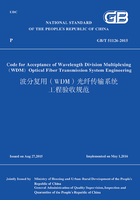
2.1 Terms
2.1.1 Conventional band
Wave band with wavelength of 1530nm-1565nm.
2.1.2 Long wavelength band
Wave band with wavelength of 1565nm-1625nm.
2.1.3 Nominal central frequency(wavelength)
Frequency(wavelength)distributed in accordance with a certain frequency space in WDM system using frequency 193.10THz(vacuum wavelength at 1552.52nm)as reference frequency(wavelength).
2.1.4 Nominal channel spacing
Nominal central frequency difference of adjacent channels.
2.1.5 Minimum side mode suppression ratio
The ratio of the largest peak of the total source spectrum to the second largest peak.The spectral resolution of the measurement shall be better(i.e.the optical filter bandwidth shall be less)than the maximum spectral width of the peak,as defined above.The second largest peak may be next to the main peak or far removed from it.In this definition,the peak value of spectrum separated by clock frequency between the largest peak and the second largest peak is not regarded as a side mode.
2.1.6 Optical amplifier span
Transmission span between adjacent OLA stations,or between OTM station and adjacent OLA station or between OADM station and adjacent OLA station in order to extend the transmission distance without O/E(Optic signal to Electric signal)conversion.
2.1.7 Optical multiplex section
Transmission section between adjacent OTM stations,or between OADM station and OTM station or between adjacent OADM stations,provided with functions of 3R(re-amplification,reshaping and retiming).
2.1.8 Optical channel
The channelin optical multiplex sectionwhere optical signal transmits unidirectionally.
2.1.9 Optical path
All equipment and measures used to transmit specific service signals in between the user interfaces of WDM equipment at signal source and signal destination.
2.1.10 Optical channel payload unit
Information structure which adapts user information to be suitbleto transmitting on optical channel.The information of user,overheads of adapted user signal rate and rate of optical channel payload unit(OPUk)as well asthe overheads of other OPUk supporting user signal transmissionare combined in the structure.These overheads are specifically adaptive ones.The capacity of OPUk is distinguished by k,k=0,1,2,2e,3,4.
2.1.11 Optical channel data unit
Information structure which contains OPUk and the relevant overheads of ODUk(optical channel data unit).The capacity of ODUk is distinguished by k,k=0,1,2,2e,3,4.
2.1.12 Optical channel transport unit
Information structure which transmits one optical channel data unit(ODUk)on one or more optical channel connections,which contains ODUk and the related overheads(FEC and optical channel connection management overheads)of optical channel transport unit(OTUk),characterized by frame structure,bit rate and bandwidth.Rate of OTUk is distinguished by k,k=1,2,3,4.Presently,two kinds of OTUk have been defined,one is totally standardized OTUk used only for OTM inter-domain interface(IrDI)or OTM intra-domain interface(IaDI),the other is OTUk(OTUkV)with partially standardized functions only used for OTM intra-domain interface(IaDI).
2.1.13 Optical supervisory channel
Physical optical path which transmit OTM overhead signals,and optical supervisory channel(OSC)does not pass through optical amplifiers.